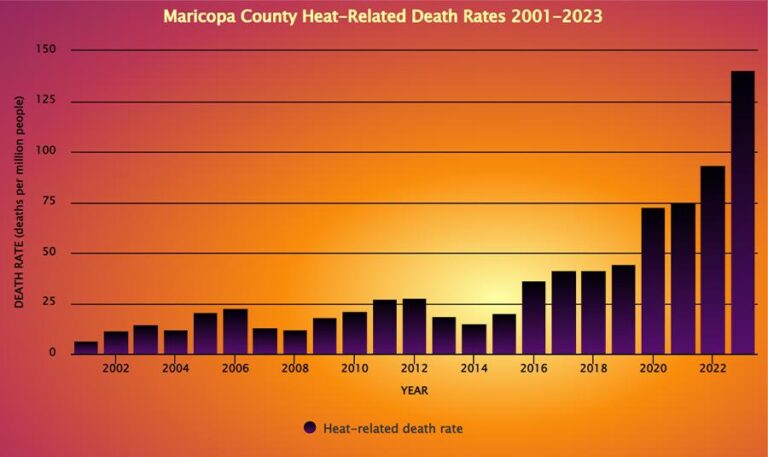Rising Heat-Related Fatalities in Phoenix Spotlight Urgent Public Health Crisis
Surge in Heat-Linked Deaths Sparks Concern Across Phoenix
This summer, Phoenix has been grappling with unprecedented heat waves, pushing temperatures to historic highs. In the wake of this extreme weather, local officials are investigating over 300 suspected deaths attributed to heat exposure. This alarming figure has intensified worries about the adequacy of current public health strategies, including the availability and accessibility of cooling centers and the effectiveness of heat safety communications. Vulnerable groups‚ÄĒsuch as seniors, individuals experiencing homelessness, and those with chronic illnesses‚ÄĒare being urged to exercise heightened caution. Emergency services are operating at full capacity, underscoring the critical need for community vigilance and support.
Health professionals advocate for several key precautions to mitigate heat-related risks, including:
- Maintaining hydration: Regular intake of water is essential to prevent dehydration and heat-related illnesses.
- Reducing outdoor exposure: Avoiding outdoor activities during the hottest parts of the day minimizes risk.
- Utilizing cooling facilities: Access to air-conditioned spaces remains a vital protective measure.
- Supporting at-risk individuals: Community check-ins can save lives by ensuring vulnerable people receive assistance.
| Group | Suggested Precautions | Risk Severity |
|---|---|---|
| Seniors | Stay indoors, drink fluids frequently | High |
| Homeless Population | Visit cooling centers, seek medical attention if symptoms arise | Very High |
| Outdoor Laborers | Take regular breaks in shaded or cooled areas | Moderate |
| Children | Limit vigorous play, ensure hydration | High |
Analyzing Contributing Factors Behind Heat-Related Fatalities
Investigations into the recent spike in heat-related deaths in Phoenix reveal a complex interplay of environmental and social factors. Experts highlight that the combination of soaring temperatures and socio-economic challenges has created a perilous situation for many residents. Chronic medical conditions, limited access to cooling resources, and prolonged heat exposure are significant contributors. Notably, many victims were discovered in isolation, pointing to social detachment as a critical risk factor.
Data indicates that certain demographics bear a disproportionate burden of heat-related health risks. The elderly, homeless individuals, and outdoor workers are particularly vulnerable. Socioeconomic disparities, including restricted healthcare access and insufficient community support, exacerbate these risks. Key risk factors identified include:
- Age 65 and older: Increased sensitivity to heat stress and complications
- Low-income status: Limited means to afford air conditioning or cooling devices
- Pre-existing health conditions: Cardiovascular and respiratory illnesses heighten vulnerability
- Outdoor employment: Extended exposure during peak heat periods
- Social isolation: Lack of regular monitoring and assistance
| Risk Factor | Severity | Proportion of Cases |
|---|---|---|
| Senior Citizens | High | 47% |
| Low-Income Individuals | Moderate | 33% |
| Chronic Health Conditions | High | 55% |
| Outdoor Workers | Moderate | 22% |
| Socially Isolated Persons | High | 40% |
Urgent Calls from Health Authorities to Mitigate Heat Risks
In light of the escalating heat crisis, Phoenix health officials are urging residents to adopt immediate protective behaviors. The surge in suspected heat-related deaths has underscored the necessity of proactive prevention, particularly for high-risk groups such as seniors, outdoor laborers, and those with underlying health issues. Recommended actions include:
- Consistent hydration: Drinking water regularly, without waiting for thirst cues.
- Accessing cooled environments: Making use of cooling centers and minimizing time spent in direct sunlight.
- Community outreach: Checking on neighbors and family members who may be vulnerable or isolated.
- Scheduling activities wisely: Planning outdoor work or exercise during cooler morning or evening hours.
To enhance public understanding, officials have shared a heat risk chart detailing temperature ranges, associated dangers, and recommended precautions:
| Temperature (¬įF) | Risk Category | Suggested Precautions |
|---|---|---|
| 90-99 | Moderate | Maintain hydration, avoid midday sun |
| 100-109 | High | Limit outdoor exposure, use air conditioning |
| 110 and above | Extreme | Seek immediate shelter, monitor vulnerable individuals |
Effective Strategies to Protect Yourself During Intense Heat Waves
When facing extreme heat conditions, adopting preventive habits is essential to avoid heat-related illnesses and fatalities. Experts recommend drinking ample water throughout the day while steering clear of dehydrating beverages like caffeine and alcohol. Limiting outdoor exposure during peak heat hours‚ÄĒtypically from 10 a.m. to 4 p.m.‚ÄĒand seeking air-conditioned spaces whenever possible are critical steps. Wearing breathable, loose-fitting clothing and applying sunscreen can further shield the body from heat stress.
Families and communities should remain proactive by regularly checking on those most at risk, including seniors, young children, and individuals with chronic health issues. Public cooling centers and hydration stations provide vital relief during heat waves and should be widely promoted. The following table summarizes essential safety measures for coping with extreme heat:
| Safety Practice | Importance |
|---|---|
| Hydrate Frequently | Prevents dehydration and heat-related illnesses |
| Avoid Peak Sun Hours | Minimizes exposure to dangerous temperatures |
| Wear Light Clothing | Helps regulate body temperature and protects skin |
| Use Cooling Facilities | Provides essential respite from heat |
| Monitor Vulnerable People | Ensures timely assistance and reduces risk |
Looking Ahead: Addressing Heat Risks Amid Climate Challenges
As investigations into the over 300 suspected heat-related deaths in Phoenix continue, public health officials stress the critical importance of heightened awareness and preventive action during extreme heat episodes. Residents are encouraged to stay informed about heat dangers and to utilize resources such as cooling centers and community support networks. This ongoing crisis not only highlights the immediate threats posed by record-breaking temperatures but also reflects broader issues related to climate change and urban heat management, particularly in vulnerable populations. Continued updates will be provided as new data emerges.






